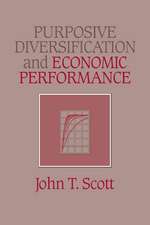Public Accountability: Evaluating Technology-Based Institutions
Autor Albert N. Link, John T. Scotten Limba Engleză Paperback – 2 noi 2012
The authors begin with a review of the legislative history of fiscal accountability beginning with the Budget and Accounting Act of 1921, and ending with the Government Performance and Results Act of 1993. A discussion of existing applicable economic models, methods, and associated metrics follows. The book concludes with evaluation case studies.
| Toate formatele și edițiile | Preț | Express |
|---|---|---|
| Paperback (1) | 635.01 lei 6-8 săpt. | |
| Springer Us – 2 noi 2012 | 635.01 lei 6-8 săpt. | |
| Hardback (1) | 641.03 lei 6-8 săpt. | |
| Springer Us – 31 oct 1998 | 641.03 lei 6-8 săpt. |
Preț: 635.01 lei
Preț vechi: 747.06 lei
-15% Nou
Puncte Express: 953
Preț estimativ în valută:
121.53€ • 125.80$ • 102.72£
121.53€ • 125.80$ • 102.72£
Carte tipărită la comandă
Livrare economică 05-19 martie
Preluare comenzi: 021 569.72.76
Specificații
ISBN-13: 9781461375807
ISBN-10: 1461375800
Pagini: 184
Ilustrații: XIII, 167 p.
Dimensiuni: 155 x 235 x 10 mm
Greutate: 0.27 kg
Ediția:Softcover reprint of the original 1st ed. 1998
Editura: Springer Us
Colecția Springer
Locul publicării:New York, NY, United States
ISBN-10: 1461375800
Pagini: 184
Ilustrații: XIII, 167 p.
Dimensiuni: 155 x 235 x 10 mm
Greutate: 0.27 kg
Ediția:Softcover reprint of the original 1st ed. 1998
Editura: Springer Us
Colecția Springer
Locul publicării:New York, NY, United States
Public țintă
ResearchCuprins
1 Introduction: Why Evaluate Public Institutions.- Overview of the Book.- 2 Public Policies Toward Public Accountability.- Performance Accountability.- Fiscal Accountability.- Conclusions.- 3 Economic Models Applicable to Institutional Evaluation.- Counterfactual Evaluation Model Contrasted with Griliches/Mansfield and Related Evaluation Models.- Conclusions.- 4 Performance Evaluation Metrics.- Internal Rate of Return.- Implied Rate of Return.- Ratio of Benefits-to-Costs.- Conclusions.- 5 Case Studies: An Overview.- A Brief History of NIST.- Evaluation Activities of the Program Office.- Evaluation Activities of the Advanced Technology Program.- Conclusions.- 6 Optical Detector Calibration Program.- Optical Detector Calibration.- Optical Detector Technology.- U.S. Optical Detector Industry.- Economic Impact Assessment.- Conclusions.- 7 Thermocouple Calibration Program.- Thermocouples: A Technical Overview.- Thermocouples: An Industrial Overview.- Economic Impact Assessment.- Conclusions.- 8 Software Error Compensation Research.- Market for Coordinate Measuring Machines.- Software Error Compensation Technology.- NIST’s Role in the Development and Diffusion of SEC.- Economic Impact Assessment.- Conclusions.- 9 Ceramic Phase Diagram Program.- Phase Equilibria Program.- Role of Phase Diagrams in Industrial Applications.- Industry and Market for Advanced Ceramics.- Economic Impact Assessment.- Conclusions.- 10 Alternative Refrigerant Research Program.- NIST Research Related to Alternative Refrigerants.- Technical Overview of Alternative Refrigerants.- Overview of the Refrigerant Industry.- Economic Impact Assessment.- Conclusions.- 11 Spectral Irradiance Standards.- The FASCAL Laboratory.- Economic Impact Assessment.- Conclusions.- 12 Printed Wiring Board Research JointVenture.- Overview of the Printed Wiring Board Industry.- Printed Wiring Board Research Joint Venture.- Research Cost Savings, Early Productivity Gains, and Other Effects.- Conclusions.- 13 Flat Panel Display Joint Venture.- U.S. Flat Panel Display Industry and Technology.- ATP-Funded Rat Panel Display Joint Venture.- Partial Economic Analysis of the Joint Venture.- Conclusions.- 14 Toward Best Practices in Performance Evaluation.- Summarizing the NIST Experience.- Toward Best Practices in Performance Evaluation.- References.





















